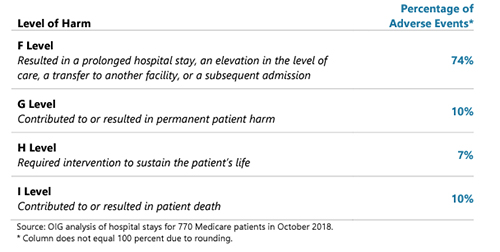That statistic of 25% figures prominently in both the website and official report. It is designed to get your attention, but you are misinformed if you stop reading there. Let’s spend a few moments delving deeper.
13% of patients experienced a temporary harm event requiring medical intervention but did not require prolonged care or result in more severe complications. The development of low blood sugar in a patient with diabetes requiring orange juice or another quick source of glucose is a temporary harm event.
12% of patients experienced an adverse event – events scaled from prolonged hospitalization to “permanent harm, requiring life-saving intervention, or resulted in or contributed to death.”
 As the table indicates, three-quarters of these events resulted in longer, more expensive care, clearly an adverse economic effect but did they reflect “harmed” health? The remaining 25% did experience harm to their health. The 25% of all hospitalized patients have now been reduced to 4% - 1 out of 25 is still not good, but it doesn’t grab your attention like 25%. More importantly, those patients with adverse events were not risk-stratified, making it hard to identify the most fragile and susceptible to cascading events where one event leads to another in a downward spiral.
As the table indicates, three-quarters of these events resulted in longer, more expensive care, clearly an adverse economic effect but did they reflect “harmed” health? The remaining 25% did experience harm to their health. The 25% of all hospitalized patients have now been reduced to 4% - 1 out of 25 is still not good, but it doesn’t grab your attention like 25%. More importantly, those patients with adverse events were not risk-stratified, making it hard to identify the most fragile and susceptible to cascading events where one event leads to another in a downward spiral.
“The overall harm rate would be 13 percent if we were to include only events that our physician-reviewers determined were preventable.”
Here is another instance where that 25% of harm is significantly reduced when framed differently, and I would argue more appropriately. The reviewers found that over half of the harm events, temporary or adverse, were not preventable; the medical staff met the standards of care. The remaining 46% involved avoidable events, and nearly two-thirds were associated with substandard care. A rough calculation reduces that 25% of all hospitalized patients harmed to 8% - 1 out of 12 is still not good, but it doesn’t grab your attention like 25%, does it?
CMS has been aware of preventable events and substandard care for some time. They have instituted lists of “preventable” events that penalize hospitals and result in reduced payments. But only 5% or less of the events noted in the Inspector General’s study were on those lists. As you might anticipate, the IG recommended expanding the list. Beginning in 2023, 5 years after the survey, CMS will add measures of low blood sugar to their preventable events. Parenthetically, in the IG survey, low blood sugar resulted in temporary harm, not in adverse health outcomes or increased costs. But blood sugar is easily monitored; it is low-hanging prevention if only it had a more significant impact.
“HHS agencies have reported progress during the past decade toward improving patient safety…”
 Like many of the numbers in this study, progress is in the eye of the beholder. What have ten years, countless hours, and expenditures gotten us? A 1% reduction in preventable events.
Like many of the numbers in this study, progress is in the eye of the beholder. What have ten years, countless hours, and expenditures gotten us? A 1% reduction in preventable events.
The sharp-eyed amongst us may have noted that n-value, the number of study participants. In the work's most significant limitation, these results review 770 randomly selected patient records for one month in 2018.
During that same interval, over 1 million Medicare beneficiaries were hospitalized. As a result,
- “The sample size was insufficient to effectively compare the results of this report to the harm rates identified in the 2010 report.”
- “The sample size was also insufficient to calculate the total dollar amounts of cost estimates with a high level of precision.”
- “Finally, the Medicare population consists of patients who are either aged or disabled and may have more comorbidities than younger, healthier patients. … Therefore, the findings of this review do not fully apply to the broader patient population.”
A Final Thought
How many policy makers read the report or were satisfied with the executive summary or, even more likely, a summary of the summary from one of their staff? Any degree of harm is bad, but what is the real rate of harm? 25%, 12%, 8%, or 4% - it depends on how you define harm. Unless you spent the time to read the 100-plus pages of the study and recognize its limitations, you were left with 1 in 4 Medicare beneficiaries being harmed by our health system. Misinformation. Whether intentional or not, “What we have here is a failure to communicate.”
Source: Adverse Events in Hospitals: A Quarter of Medicare Patients Experienced Harm in October 2018
Writer's Note: I was drawn to this because I wanted some background on my article on RaDonda Vaught.




